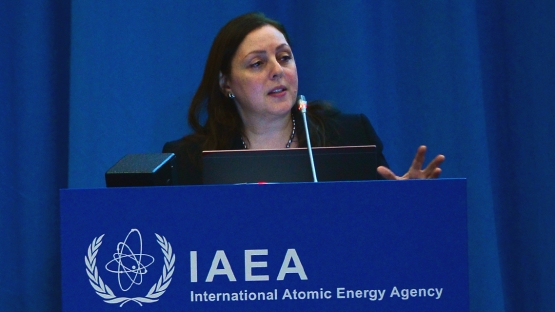On 19-20 September in Vienna (Austria), the IAEA held its annual Scientific Forum that focused on Nuclear Techniques in Human Health: Prevention, Diagnosis, and Treatment. To draw attention to the important use of nuclear science and technology and the IAEA’s role in this field May Abdel-Wahab, Director, IAEA Division of Human Health explains how this technology can benefit human health.
The field of medicine has seen unique advances over the last century — among them is the discovery of radiation and radionuclides for use in medicine. This has led to more diversified and effective prevention, diagnostic and treatment options for many health conditions. Diseases like cancer can now be diagnosed earlier and treated more effectively with the help of nuclear techniques, thus giving more patients a fighting chance and, for many, a significant chance for a cure.
Nevertheless, the increasing number of people each year affected by non-communicable diseases (NCDs), such as cancer and neurological and cardiovascular disorders, places great pressure on healthcare systems and leaders worldwide to provide effective solutions, even though the resources to diagnose and treat these conditions may be scarce, or often not available. The IAEA programme in human health contributes to the many ongoing global efforts to address these health challenges and enhance capabilities in Member States.
The Human Health Programme provides a comprehensive approach to the prevention, diagnosis and treatment of NCDs in four main areas of support: nutrition; diagnosis and follow-up; radiation oncology and radiotherapy; and quality assurance. Together, they contribute to the achievement of Goal 3 of the United Nations Sustainable Development Goals (SDGs) — good health and well-being.
Good nutrition is the foundation of human well-being. The IAEA supports the SDGs through the application of nuclear techniques, in particular using stable isotopes for disease prevention and life in good health. The IAEA enhances countries’ capabilities and helps them combat malnutrition in all its forms and promote better health throughout life by encouraging the use of accurate nuclear techniques (including stable isotopes) to design and evaluate interventions, with a focus on infant and young child feeding; maternal and adolescent nutrition; high-quality diets; prevention and control of NCDs; and healthy ageing.
Recognizing that the resources available for health vary significantly between and across regions, the IAEA develops strategies to support Member States optimize their resources without compromising the quality of the services provided. This requires careful selection of treatment options which, in turn, relies on a clear understanding of the disease and the stage it has reached. Nuclear medicine and diagnostic imaging play a key role in the diagnosis and management of NCDs. Imaging permits screening of populations at risk, early and accurate diagnosis and careful prognostic assessment — all of these leading to appropriate therapeutic decisions and monitoring of treatment. In addition, the IAEA provides technical expertise in radiotherapy, which involves the use of ionizing radiation in the treatment of patients with cancer as well as some benign conditions.
Training professionals
The lack of qualified professionals is one of the main obstacles preventing the sorely needed modernization and expansion of radiotherapy services in the developing world. Adequate human resource planning is needed to accompany government investment in equipment. Supporting initial education and training of radiotherapy professionals, such as medical physicists, radiation therapy technologists and radiation oncologists, as well as continuing education and training of previously trained professionals to update or expand their knowledge and skills is a priority.
The IAEA enhances Member States’ capabilities in the design of sound policies for radiotherapy, cancer treatment and other applications of radiation in human health. Other research activities include the applications of radiation biology, mainly in the areas of clinical biological dosimetry, tissue sterilization for tissue banking, and instructive surfaces and scaffolds in tissue engineering.
It is estimated that 10 million people each day undergo diagnostic, therapeutic or interventional procedures involving medical radiation. While the majority of these procedures are performed safely and appropriately, there are situations throughout the world where radiation protection and safety are either lacking or deficient, creating a risk to patient health. For this reason, ensuring the safe use of radiation procedures is an integral part of the IAEA’s work and mandate.
The methods used for imaging and treatment require accurate dosimetry and complex quality assurance procedures to ensure that appropriate clinical outcomes can be achieved without compromising the safety of the patient. The IAEA develops internationally harmonized codes of practice and guidelines for dosimetry and quality assurance, as well as recommendations for best practices, and provides guidance to Member States for their implementation. It also maintains a dosimetry laboratory, which plays a key role in establishing and disseminating best practices for the safe, secure and effective use of radiation in the diagnosis and treatment of cancer.





